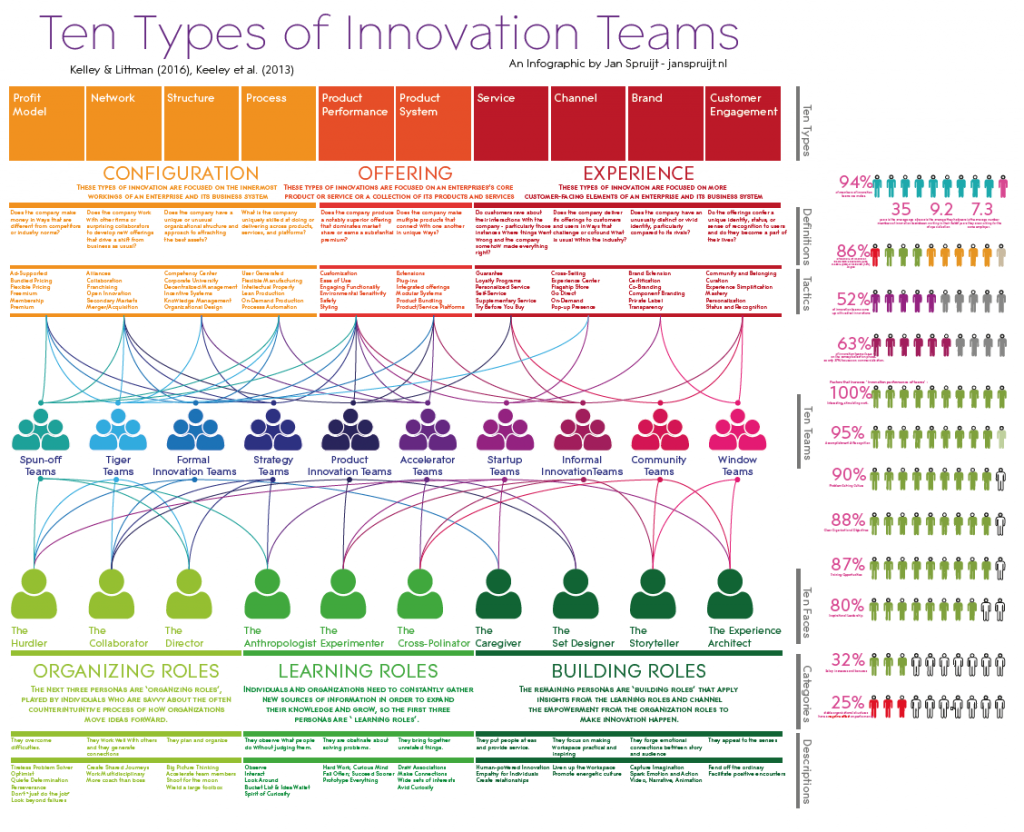When the book “Ten Types of Innovation” (Keeley et al.), in its most recent format, hit the shelves in 2013 – not only me, but many of my colleagues in higher education, embraced the work because of its clarity and integrality. It offered a much richer approach than the usual – perhaps more scientifically evidenced – approach of 4 types of innovation (product innovation, process innovation, business model innovation, service innovation). The work was, and still is, one of the most influential works used in our Business Innovation program and highly rewarded by both students and partners in the field. The infographic I made in 2014 based on this book has been one of the most downloaded infographics on this blog ever since.
Parallel to that, but completely different in its approach, the work “Ten Faces of Innovation” (Kelley), acquired the same fame over the years. It was highly rewarded as a book that offered an approach to dealing with different roles in innovation teams – roles that were not necessarily bound to 1 person and are highly practical from nature – much more practical than for instance the typology mentioned in the Innovator’s DNA – which looks at roles from a more abstract, ambidextrous, point-of-view. The Ten Faces shouldn’t be used to tag people with specific skills (something that for instance DISC does), but can be used to start a deliberate conversation with your (innovation) team members about their strengths and ambitions.

This infographic is part of the book Innographics: A Visual Guide to Innovation Management
Download a 32-page preview for free
Including 2 infographics, 2 chapters and an overview of 28 innographics.
☑ I agree with opting in for the newsletter, our terms and privacy policy.

Innovation Teams
But something that neither of them discuss is the existence and consistence of innovation teams. In innovation science the construct of an ‘innovation team’ is often overlooked – as if there is only one sort of innovation teams: the team that innovates and is run by innovators. In reality however, I came across many distinguishing approaches to what we could call innovation teams. They all have different set-ups and different aims. Drawing on my own experience (examples below) and backed by the models of Ten Types of Innovation and Ten Faces of Innovation, I deducted 10 Types of Innovation Teams. Let me introduce them to you:
1. Spun-off Teams
- Ten Faces: the hurdler, the director and the anthropologist
- Ten Types: profit model innovation, network innovation, process innovation, product innovation;
Spun-off Innovation Teams are teams consisting of seasoned entrepreneurs who have gained experience in SME or large corporations, created or designed a highly marketable technology or business model. They usually patent their idea from within the mothership and from then on collaborate with them to spin-out their business to increase chances of bringing it to market successfully.
2. Tiger Teams
- Ten Faces: the hurdler, the collaborator, the director
- Ten Types: profit model innovation, network innovation, structure innovation, process innovation, channel innovation
Tiger Teams are one-of-a-kind. They consist of influential innovators or project managers from within your organization. Their task usually is to dive into an immediate problem and come up with an innovative solution to overcome the problems. A problem could be that one of your suppliers is financially unstable, which rings all bells in your organization’s risk analysis. A Tiger Team can then be sent to the supplier to “overtake” their current business operations, create innovative managerial solutions and get things back on track. A Tiger Team could also intervene internally in organizational redesign or when opening up your business model. Tiger Teams will be able to deal with resistance and have a strong focus on the human impact of change.
3. Formal Innovation Teams
- Ten Faces: the hurdler, the collaborator, the caregiver
- Ten Types: profit model innovation, network innovation, process innovation, product innovation and product system innovation
Formal Innovation Teams are the teams we usually refer then framing innovation teams. They consist of powerful innovators with vision and a strong internal and external network to get things done. Innovation is not something they ‘do’ fulltime: they are freed of other tasks for 1-2 days a week and use this time to create shared visions, initiate new projects or follow top-down leads that may be interesting. They usually have some kind of stage-gate-model in place to be able to monitor and report about their progress.
4. Strategy Teams
- Ten Faces: the collaborator, the director, the anthropologist
- Ten Types: profit model innovation, network innovation, structure innovation, product innovation
Strategy Teams are responsible for developing new strategic directions. They thoroughly research market trends and user experiences in order to design new visions and possible scenarios for the organizations. Their task is to report continuously about these findings and suggest the creation of new business models for the organizations. They usually operate at a high level in the organization, are usually multidisciplinary and strongly intertwined with experts from universities to help them grasp the most important findings.
5. Product Innovation Teams
- Ten Faces: the collaborator, the experimenter, the set designer
- Ten Types: network innovation, product innovation, product system innovation, service innovation
Product Innovation Teams are an export product of the Agile Movement. Many organizations have recently transformed into ‘agile communities’ which includes (temporary, but fulltime) product innovation teams who are responsible for the full development of an idea completely to a market-ready stage. In digital companies they may take the form of scrum teams. The teams are usually flexible, but dedicated and result-oriented. They are makers and make sure to test and validate the product with users before its final implementation.
6. Accelerator Teams
- Ten Faces: the anthropologist, the cross-polinator, the set designer
- Ten Types: structure innovation, process innovation, product innovation, product system innovation
Accelerator Teams operate with innovation on another level: they don’t innovate themselves, but the facilitate innovation in their organization – using an innovative approach in doing so. They create spirit, they create learning spaces, they create inspiration, they build bridges, they make seemingly unrelated relations. With their approach they create a climate for innovation within the company that, in the long run, creates a process of continuous reinvention of the organization.
7. Startup Teams
- Ten Faces: the hurdler, the experimenter, the caregiver, the experience architect
- Ten Types: product innovation, channel innovation, brand innovation
Startup Teams consist of young, usually relatively unexperienced, innovators that have a specific mission in mind and are willing to iterate as long as possible until the mission becomes reality. They focus on creating minimum viable products and building strong brands on top of that. They create a flavor of freshness around the product and do not settle for known paths to market. To start online and stay online.
8. Informal Innovation Teams
- Ten Faces: the experimenter, the cross-polinator, the storytellers
- Ten Types: product innovation, product system innovation, service innovation, customer engagement innovation.
The informal nnovation teams breath idea generation. These are hidden ‘teams’, walking between the lines of the other teams. The create ideas at a non-stop basis and their influence in the organizations to bring the ideas to the more formal teams in order to realize them. Behind the scenes, they’ll stay involve to see how their ideas end up or if they should pull some more strings. These kind of teams are highly valuable to organizations: they exist everywhere, but are only appreciated in organizations with a strong innovation climate. They don’t want to be formalized, so let them be.
9. Community Teams
- Ten Faces: the cross-polinator, the storyteller, the experience architect.
- Ten Types: service innovation, customer engagement innovation
Community Teams drive innovation through the (user) community of the organizations. They try to continuously interact with the customers and involve external users in the creation of new opportunities for offering increased service and enhanced customer satisfaction. They use visual techniques and are tech-savvy in their ways to reach out and they growth hack their way into your innovation funnel. Their ideas may just be as good as the anthropologist’s ideas.
10. Window Teams
- Ten Faces: the storyteller, the experience architect
- Ten Types: brand innovation, customer engagement innovation
Window Teams are highly specialized in reinventing your brand and reputation. They will ideate, design and implement innovations that the outside world sees when googling for your organization. They usually consist of marketing-communication experts, graphical designers and fashionista’s and usually operate at a high level in the organization, because it’s not what’s good that gets the attention of the board but what gets wrong. Not having Window Teams may be bad for your reputation: nobody still believes that your product sells itself, do you?
Pingback: Type of Innovation – Sensaco
Pingback: Innovations-Typen » Sensaco
Great piece! Great how you bridged between 10 faces and 10 types of … and thanks for sharing so generously! Cheers, Erik
Great Article. Can and should turn into a book!
Thank you Jan.
Cheers, Amir